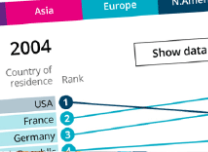Employment and labour market Labour market economic commentary: Apr 2017
The unemployment rate was 4.7% in the 3 months to February 2017, down from 5.1% a year earlier; it has not been lower since June to August 1975.
Strong demand for labour is translating into a shift from part-time to full-time employment, and an increase in the average hours worked per week by both full time and part-time employees.
The number of vacancies increased by 2.1% between the last quarter of 2016 and the first quarter of 2017 to 767,000, the highest level on record. Regional labour market statistics in the UK: Apr 2017
For the 3 months ending February 2017, the highest employment rate in the UK was in the South West (78.8%) and the lowest was in Northern Ireland (68.8%).
For the 3 months ending February 2017, the highest unemployment rate in the UK was in the North East (6.4%) and the lowest was in the South East (3.4%). UK labour market statistics: Apr 2017 Estimates from the Labour Force Survey show that, between September to November 2016 and the three months to February 2017, the number of people in work increased, the number of unemployed people fell, and the number of people aged from 16 to 64 not working and not seeking or available to work (economically inactive) also fell. There were 31.84 million people in work, 39,000 more than for September to November 2016 and 312,000 more than for a year earlier. The employment rate (the proportion of people aged from 16 to 64 who were in work) was 74.6%, the joint highest since comparable records began in 1971. People, population and community International immigration and the labour market, UK: 2016 In 2016, 11% (3.4 million +/- 0.2 million) of the UK labour market (30.3 million +/- 0.3 million) were non-UK nationals; EU nationals contributed 7% (2.2 million +/- 0.1 million) and non-EU nationals 4% (1.2 million +/- 0.1 million). There are higher proportions of international migrants in some industry sectors more than others; particularly the 14% of the wholesale and retail trade, hotels and restaurants workforce are international migrants (508,000 (+/- 64,000) EU nationals are employed here) and 12% of the financial and business services sector's workforce are international migrants (382,000 (+/- 56,000) of which are EU nationals); 8% of workers in manufacturing are EU8 nationals. 701,000 non-UK nationals work in the public administration, education and health sector; over a quarter of EU14 workers (27%) and non-EU workers (29%) are employed in these industries. | 









No comments:
Post a Comment